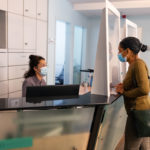
By Justin Manning, OD, MPH, FAAO
Dec. 1, 2021
Customer journey mapping is a powerful way to evaluate and enhance the customer experience within any business, especially when those customers are patients within an optometric practice. Just as the name indicates, this process involves “mapping” the customer, or patient, journey from start to finish within the business – from when they first gain awareness of the need for goods/services to what they experience post-transaction.
Each step of the patient journey is an opportunity to deliver an incredible experience or an opportunity for things to go wrong. At its core, customer experience is about delivering value in the eyes of the customer and making that value both easy to obtain and the process of obtaining it enjoyable. The greater the value, the easier it is to obtain it, and the more enjoyable it is, the better the customer experience.
Detailing the patient journey provides a practice owner insight into how the patient feels, what they experience, what they desire and what must be improved in each step of the patient experience. It is important to note that it’s easy to get hung up on the typical patient journey for a comprehensive eye exam, yet there are many patient journeys within the business.
For example, the patient journey is different for comprehensive exams, medical visits (new presentation or follow-up), retail purchasing/optical, cash-pay advanced services and all the other services you provide. Each journey has multiple steps, and therein, opportunities to differentiate your practice from competitors. Some journeys may be similar, but the differences are where you have the opportunity to shine.
Step 1: Determine Which Journey You Are Mapping & Create a High-Level Journey Map
For the purposes of this article, let’s use a comprehensive eye exam as an example of a patient journey you’re mapping. Once you determine the specific journey, you will create a high-level journey map that identifies the individual steps within the journey. When creating the high-level map, it’s important to go as far out as the patient gaining awareness they have a problem and need your services (a need for an eye exam in this case). From there, ask yourself what is the next step in the journey? Continue identifying each step in the journey until you’ve come full circle.
In the case of a comprehensive eye exam, it may look like the following:
1. Awareness of problem and doctor research
2. Interaction with your practice digitally – website, social media
3. Appointment scheduling
4. Appointment confirmation
5. Patient check -in
6. Pretesting
7. Exam
8. Optical
9. Check-out and exam preset
10. Next exam remainder/appointment confirmation
Your patient journey map may look slightly different from this. Remember, there are multiple journeys you can create a high-level journey map for.
Step 2: Zoom In On the Details of Each Step of the Patient Journey
Once you’ve created your high-level journey map, zoom in on each step to create your detailed journey map. For your typical patient, answer the following questions:
1. What’s the channel that the patient is using/how are they interacting with your business? (i.e. website, smartphone, in-person, phone, etc.)
2. What exactly are they doing at each step?
3. What are their emotions?
4. What are their questions and/or concerns?
5. How do you want them to feel during each step?
6. What are the roadblocks to success during each step?
7. How can you improve each step in the journey?
8. For each step, ask, is this a needed improvement that should be fixed right away or is it lower priority? Is it a quick fix?
At first, this may be daunting, but the process of creating your detailed journey map should take no more than 30-45 minutes. I highly encourage you to work with each person on your team to answer these questions. Your employees are likely to know best the answers to these questions for their own areas of the journey.
Other Articles to Explore
In addition, your employees are likely to have ideas for answering questions 6-8. This makes your life as the owner easier and empowers/engages your team members to contribute to a greater patient experience. And don’t be afraid to get patient feedback about each step of the journey to answer these questions.
Step 3: Determine How to Make Needed Improvements for Each Step of the Journey
Once you determine the ways you can improve each step of the journey, determine the actions that need to be taken to fix the highest priorities, and get to work!
I’ve written previously about how I used design thinking to build a specialty contact lens practice in Colorado Springs. As part of the design thinking process, we looked at the patient journey for a keratoconic patient in other practices and found significant areas for improvement.
We found during the awareness step (e.g. I need to find a scleral lens/contact lens fitter) there were significant challenges to a great experience. The biggest was that the patient had trouble determining which practices/doctors were specialty lens fitting experts and which were not. This led to patient feelings of concern, anxiety and worry. So, we built a website specifically for specialty contact lenses and keratoconus. In addition, we built a Google business page for the specialty contact lens side of the practice.
There are often many follow-up visits during the scleral lens fitting process. Each of these visits is a step in the patient journey. We identified that the time between fitting/adjusting the lens and receiving/dispensing the new lenses was often at least 10-14 days. There wasn’t always great communication about the status of lens orders, which left these patients feeling frustrated and anxious. To address this, we worked with the lab to get an average 4-5 day turnaround time on lenses ordered and we guaranteed the patient they’d be scheduled for a dispense visit within two days of the lenses arriving. In the case of an adjustment, the patient often could pick up their lenses that day and come back for a follow-up within a few days.
Once you know where the office experience you are providing patients is falling short, you can make targeted improvements that boost both care and practice growth.
 Justin Manning, OD, MPH, FAAO, is the executive vice-president of professional strategies at Healthy Eyes Advantage (HEA). He can be reached at JManningOD@hea2020.com.
Justin Manning, OD, MPH, FAAO, is the executive vice-president of professional strategies at Healthy Eyes Advantage (HEA). He can be reached at JManningOD@hea2020.com.

























